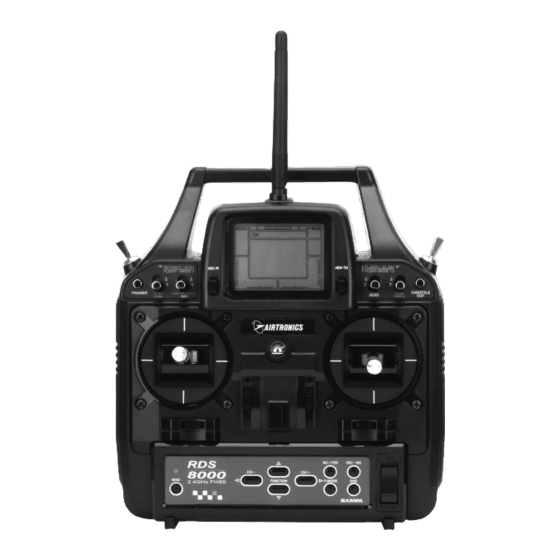AIRTRONICS RDS8000 FHSS Manual de inicio rápido - Página 3
Navegue en línea o descargue pdf Manual de inicio rápido para Mando a distancia AIRTRONICS RDS8000 FHSS. AIRTRONICS RDS8000 FHSS 4 páginas. For aircraft

As an example, assume we want to program our RDS8000 for use with a 4-channel type model with Elevator, Aileron, Rudder and
Throttle controls. Check to see that all of the switches on the front panel are in the OFF, (e.g., down position). Make sure your
control surfaces are as close to neutral as possible using your adjustable quick links. You can then fine-tune them using the
Centering (CNT) control.
IMPORTANT Do not use excessive values of Centering to correct a large error in control position.
Start with the Elevator channel with the screen indicating STW. Use the Down Function key to select Servo Reverse (REV). The
INC+/YES or the DEC-/NO key can be used to change the direction of throw of the servo. We are not concerned with what the
screen indicates, only if we command UP Elevator, the Elevator moves UP.
Next, press the Down Function key to select Dual Rate (D/R). When the Elevator D/R switch located on the far left near the Trainer
button is in the Down position you are in Dual Rate #1. The default value is 100% which means there is no rate applied. If you move
the switch up, the screen will indicate Dual Rate #2. It all depends on the individual flyer as to what switch position he wants for Low
Rate. You can select either #1 or #2. Assume you want Low rate with the D/R switch in the UP position, use the DEC-/NO key to
reduce the value to something less than 100%.
PRO TIP Some model instruction manuals provide what they recommend for High and Low Dual Rate. If not, then you can guess
at approximately 70% as a good starting point. Flying tests will determine the correct value.
Next, use the Down Function key to select Exponential (EXP). Exponential provides a softening of control and decreases the
sensitivity around neutral so you do not over control.
IMPORTANT The D/R switch controls whether you have Expo in position #1 or #2.
Since we want the servo movement soft in the neutral area of the stick movement, input a positive value of approximately 30% as a
starting value. Flying tests can be used to determine if you need to decrease or increase the value. If desired you can program Expo
for both Low and High rates as determined by the position of the D/R switch.
Elevator to Flap (E>F) mixing can be used to cause the Flaps to respond to Elevator control inputs if a model has Flaps or Flaperons.
The INC+/YES key is used to input the desired value. If Flaperons are Active, the Elevator stick will cause the Ailerons to move UP
and Down similar to a control line model with coupled Elevator and Flaps. Since we are only programming a four-control type model
it is not used in this example.
The remainder of the Channels, Aileron (AL), Throttle (TH), and Rudder (RU), are programmed in the same manner as done for the
Elevator (EL) channel.
Trim Memory (TRM) is available on all four of the flight control channels and on the Flap (P-F) channel. (The P indicates Pitch when
programming the unit in the Heli mode). You can use the transmitters Digital Trim keys to program trim settings for your model while
flying. All settings are automatically stored in Trim Memory for that specific model.
Prior to flying your model you should perform a Range Check. The RDS8000 has a Range Check Mode function, which lowers the
transmitter power to check for proper receiver operation at a known minimal distance. To perform the Range Check, position the
Throttle Stick to the low throttle position, press the BIND button on the transmitter with a pencil or other sharp object, and turn
ON the transmitter. The BIND LED will blink Steadily. Hold the BIND button in for approximately 5 seconds until the LED goes out.
Then release the BIND button. If the LED then resumes a steady blinking the transition to the Range Check Mode was successful.
Immediately turn ON the receiver power and walk 30 paces (approximately 90 feet) and with the help of another flyer, check to see
that all controls on the model operate correctly.
IMPORTANT The Range Check function automatically turns off in approximately 3 minutes, and the system is then in
Normal operation.
Turning off your transmitter also turns off the Range Check function. Make sure you obtain the minimal range distance. If you do not,
repeat the Range Check as per stated on page 19 of your RDS8000 manual. Do not fly your model until you meet the minimum
standards. Do not try and fly your model while in the Range Check Mode since control will be lost when the model reaches
a certain distance.
PROGRAMMING SAMPLE
RANGE CHECK MODE FUNCTION
3
